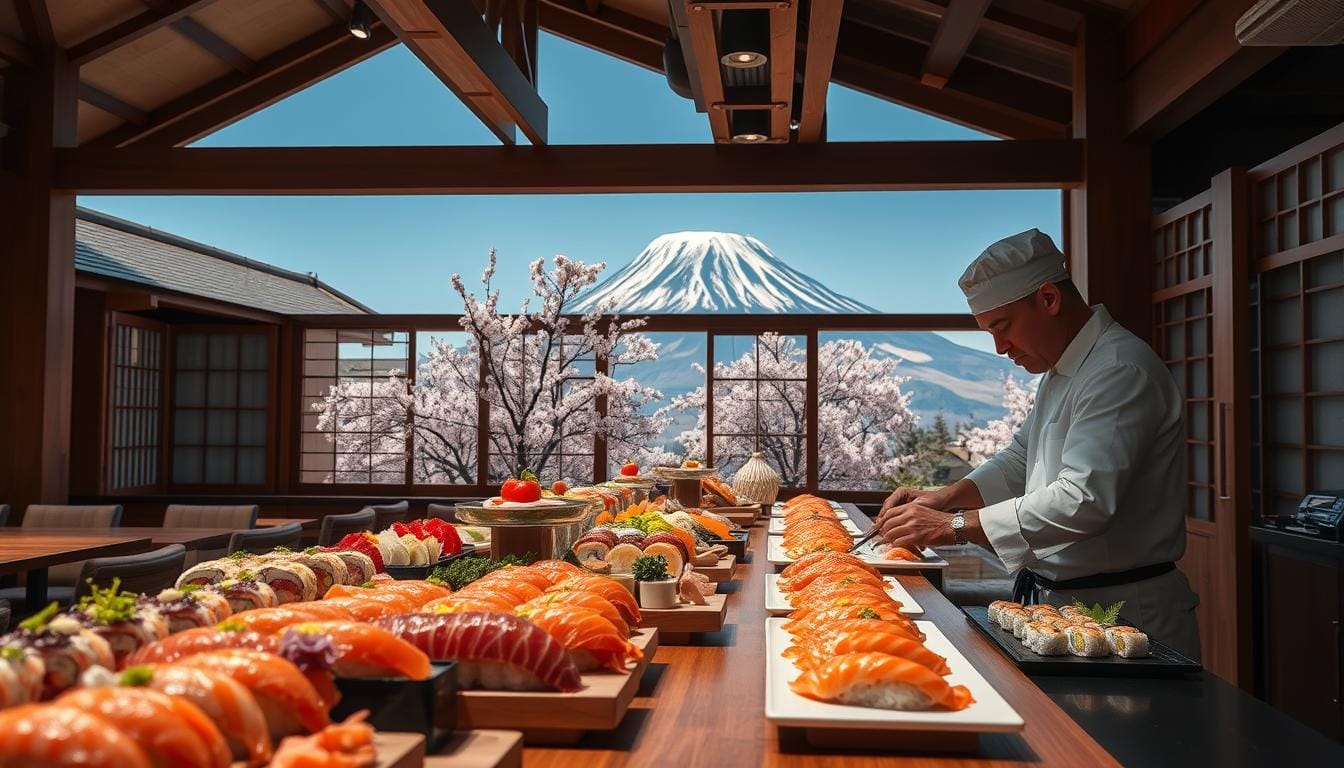Ever thought about a word that’s deeply meaningful across many cultures? Yama is a term that fascinates, linking spiritual practices, philosophy, and food. It takes us on a journey from Hindu philosophy to Japanese cuisine.
Table of Contents
In Japanese cuisine, yama sushi is more than food—it’s an art form. It blends tradition with today’s food world. Exploring yama reveals its deep meanings, showing how one word can connect different cultures.
If you’re interested in spirituality, food, or just curious about culture, learning about Yama is enlightening. We’ll explore its roots in philosophy, myths, and Japanese cuisine. This will give you a full picture of Yama’s significance.
Are you ready to explore Yama? It’s where old wisdom meets new understanding. Every meaning of Yama has a story to tell, waiting for you to discover.
Understanding Yama sushi in Hindu Philosophy
Hindu philosophy teaches us about living ethically through Yama. This concept is a set of moral rules that help us grow spiritually and personally. It guides us on our path to inner change and living mindfully.
Just as a chef makes a great sushi dish, those who follow Yama work on being more aware of their ethics. They do this through disciplined practice.
The Five Fundamental Yamas
The ancient texts tell us about five key Yamas. These are spiritual guides for us:
- Ahimsa (Non-violence): Being kind to all living things
- Satya (Truthfulness): Being honest in our thoughts and actions
- Asteya (Non-stealing): Valuing others’ things and respecting their space
- Brahmacharya (Celibacy/Energy Control): Managing our energy well
- Aparigraha (Non-possessiveness): Letting go of things we don’t need
Spiritual Practice and Transformation
Living by Yama’s principles means we must reflect on ourselves. Our spiritual journey is like making sushi, where every ingredient is valued and used with care.
| Yama Principle | Spiritual Impact | Personal Growth Potential |
|---|---|---|
| Ahimsa | Cultivates Compassion | Reduces Internal Conflict |
| Satya | Builds Trust | Enhances Personal Integrity |
| Asteya | Promotes Respect | Develops Ethical Boundaries |
Modern Interpretations of Yama Principles
Today, people see Yama as a way to live ethically. It’s like choosing the best ingredients for sushi. These principles help us live with mindfulness, respect, and purpose.
Yama as the God of Death in Hindu Mythology
In Hindu mythology, Yama is a unique god of death and justice. He is not seen as scary like in other cultures. Instead, Yama shows a deep understanding of life’s end.
His image holds deep meaning. He is known for:
- Green or black skin
- Piercing red eyes
- Crimson garments
- Carrying a noose and mace
- Riding a majestic buffalo
Preparing fresh sashimi is like Yama’s work. Both need skill, respect, and understanding of big changes. A chef turns raw fish into art, just like Yama guides souls to their next stage.
*Death is not the opposite of life, but a part of it.* – Hindu Philosophy
Yama is seen as the first person to die in Vedic traditions. He is a fair judge, judging people’s actions and their spiritual path. This is like how every detail is important in a top sushi bar.
Yama’s four-eyed dogs watch over him. They show the importance of justice and the unstoppable flow of life. Their presence is like the careful steps in making fresh sashimi.
The Eight Branches of Yoga and Yama’s Position
Yoga is a complete way to grow personally, with Yama as its moral base. It’s like making sushi, needing focus on ethics and self-control.
The first part of yoga, Yama, sets up rules for living ethically. These rules are like the high standards in sushi delivery, where respect and honesty are key.
Integration with Yogic Practices
Yama’s main rules blend well with other yoga parts, making a full way to grow. The five main rules are:
- Ahimsa: Non-violence and kindness
- Satya: Being truthful in thoughts and actions
- Asteya: Not taking or wanting what’s not yours
- Brahmacharya: Managing energy wisely
- Aparigraha: Living simply and without attachment
Contemporary Applications in Yoga
Today’s yoga followers use Yama’s rules in everyday life, like sushi chefs do their work. These rules help people find balance and mindfulness in all areas of life.
Benefits of Yama Practice
Following Yama’s rules can change how you live. You’ll know yourself better, get closer to others, and live in harmony. Just as making sushi needs careful steps, growing personally needs steady ethical practice.
“Ethical living is the foundation of true personal transformation.” – Yoga Philosophy
Yama’s Influence in Buddhist Traditions
Buddhist traditions give us a deep look into Japanese cuisine’s philosophy. The idea of Yama in Buddhism connects with the careful making of sushi. It shows a spiritual side to cooking.
In Buddhism, the idea of change is key. It’s like the quick work of making sushi. Each piece of sushi is a special moment, made with great care and respect for the ingredients. Seeing Japanese food as a way to meditate opens up a new world.
- Mindful ingredient selection reflects Buddhist principles of awareness
- Sushi preparation embodies the concept of living in the present moment
- Respect for food mirrors spiritual contemplation of life’s transient nature
Buddhism teaches that every moment is short, like sushi before it’s eaten. Chefs focus deeply on their work, making cooking a spiritual act. They honor each ingredient’s unique value.
In the world of Japanese cuisine, every slice represents a moment of profound connection between creator and consumer.
Exploring Yama in Buddhist traditions shows a deep spiritual understanding. It goes beyond traditional beliefs, touching the heart of cooking and mindful living.
The Popular Yama Sushi Restaurant Experience
Looking for a real sushi experience? Yama Sushi is your go-to spot. It’s known for top-notch Japanese food and is a favorite among locals.
Walking into Yama Sushi feels like entering a world of fine dining. It’s all about traditional Japanese food, making every meal special.
Signature Dishes That Delight
The menu at Yama Sushi is full of amazing dishes. Here’s what you can expect:
- Omakase selection with fresh, seasonal ingredients
- Signature rolls made with the best fish
- Artfully prepared sashimi platters
- Nigiri with local seafood
Traditional Japanese Dining Etiquette
“Respect for food is respect for life” – Japanese Culinary Wisdom
Yama Sushi follows traditional Japanese dining rules. Guests learn to enjoy each dish as an art form. The staff teaches how to use chopsticks and enjoy the flavors.
Customer Recommendations
People love Yama Sushi for many reasons:
- Exceptional quality of fresh fish
- Welcoming and knowledgeable staff
- Authentic Japanese dining atmosphere
- Innovative yet traditional menu offerings
Yama Sushi is perfect for both sushi newbies and experts. It offers a true sushi experience that will excite your taste buds and take you to Japan’s culinary heart.
Historical Evolution of Yama in Ancient Texts

The idea of Yama is a captivating journey through old spiritual and philosophical views. It’s like a sushi bar that keeps its main techniques but changes over time. Yama’s spiritual importance has stayed the same, even as it has evolved.
Old texts show Yama’s growth in different cultures. Scholars have found its roots in many historical writings. They’ve seen how its meaning has changed, much like how sashimi is made today.
“The evolution of philosophical concepts mirrors the delicate art of cultural preservation.” – Spiritual Research Institute
- Early Vedic references show Yama’s first ideas
- Philosophical texts later added more spiritual depth
- Its meaning changed over time
- Comparing these changes shows how it has evolved
Yama’s history is like a sushi bar’s tradition. Just as chefs improve their skills over generations, scholars have studied and rethought Yama’s main ideas.
The way Yama has changed in texts shows how old wisdom adapts but keeps its core. Like choosing the best sashimi, understanding Yama needs a deep respect for its history.
Yama’s Role in Vedic Literature
Vedic literature explores Yama, the first mortal who became a key spiritual figure. His story from human to celestial judge shows the deep connection between life and the universe.
In ancient texts, Yama is more than a mythological figure. He symbolizes complex ideas about life, death, and spiritual growth.
Interpretations Across Vedic Schools
Different Vedic schools saw Yama in different ways:
- Guardian of the southern cosmic region
- First mortal to experience death
- Judicial figure weighing human actions
- Protector of ancestral spirits
Symbolic Meanings and Representations
Yama’s symbols are like the layers in sushi, each with its own meaning. Just as sushi delivery services package their dishes with care, Vedic scholars built Yama’s story with precision.
| Symbolic Attribute | Representation |
|---|---|
| Appearance | Dark complexion, red eyes, majestic demeanor |
| Accessories | Noose, mace, skull ornaments |
| Companions | Two four-eyed dogs, crow and pigeon messengers |
Yama’s change from a joyful ruler to a judge is like the evolution in sushi delivery. It shows how tradition and innovation can come together.
Modern Applications of Yama Principles
The wisdom of Yama principles still guides us today, in Japanese cuisine. It shows how old ethics meet new culinary adventures.
In sushi, chefs live Yama’s teachings through hard work and focus. These teachings are seen in many parts of Japanese food:
- Respect for ingredients
- Meticulous preparation techniques
- Commitment to culinary excellence
- Spiritual mindfulness during cooking
Sushi chefs show Yama’s lessons through their long training and deep food philosophy. They see cooking as more than just skills. It’s a complete art that makes Japanese food special.
| Yama Principle | Culinary Application |
|---|---|
| Discipline | Precision in knife skills |
| Respect | Honoring ingredient quality |
| Mindfulness | Intentional cooking techniques |
Top sushi places use these principles in every part of their work. It turns eating into a deep journey that links old traditions with today’s dining.
“In sushi, as in life, every detail matters.” – Traditional Japanese Culinary Wisdom
By knowing these principles, you see the deep culture behind Japanese food. It’s why Japanese cuisine is loved and respected all over the world.
Yama in Japanese Cultural Context
In Japanese culture, “Yama” means more than just mountain. It carries deep cultural meaning that touches many parts of Japanese life. This includes the famous Yama Sushi restaurants, loved by food lovers everywhere.

- Strength and resilience
- Natural beauty and harmony
- Spiritual connection to landscape
- Respect for traditional elements
Traditional Japanese Interpretations
Mountains were more than just hills in Japanese thought. They stood for spiritual growth, peace, and a bond between earth and sky. This respect is seen in today’s sushi places, like Yama Sushi, which bring these values to life.
Contemporary Cultural Significance
Now, Yama Sushi restaurants show these old values in their food making. They offer more than just food, showing Japanese culture’s heart. Every step, from cutting to serving, shows the mountain’s ideals of balance and beauty.
“In every slice of sushi, we honor the mountain’s spirit of precision and beauty.” – Japanese Culinary Tradition
Yama Sushi is a true way to see Japanese taste and beauty. It’s perfect for anyone who loves food or wants to learn about Japanese culture.
The Connection Between Yama and Dharma
Exploring Yama and Dharma shows us how ethics play out in many areas, including food. Sushi making and menu planning show us how to live righteously.
Many sushi places now focus on using ingredients that are good for the planet. This shows they care about doing the right thing, just like Dharma teaches.
- Sustainable seafood sourcing reflects Dharmic values of respect
- Ethical menu design demonstrates mindful food preparation
- Responsible ingredient selection embodies spiritual consciousness
Places like Blue Sushi Sake Grill are leading the way. Their Conscious Earth program shows how choosing sashimi is more than just food. It’s a choice to do the right thing.
| Restaurant | Ethical Practice | Certification |
|---|---|---|
| Sushi Maki | Marine Stewardship Council Certification | Sustainable Seafood Sourcing |
| Hissho Sushi | 100% Responsibly Sourced Seafood | Traceability Commitment |
By choosing ingredients with care, these restaurants make eating out a special experience. It’s about enjoying great food and doing good at the same time.
The path of Dharma is not just a spiritual journey, but a way of engaging with the world consciously and compassionately.
Yama’s Significance in Different Asian Cultures
Exploring Asian cultures shows how deep Yama is in many traditions. It goes beyond simple meanings, touching different cultures deeply.
Yama’s different forms show unique views of the world. They offer a peek into how Asian societies see spiritual and mythological ideas.
Regional Variations of Yama
In various Asian cultures, Yama has its own look:
- In Hinduism, Yama is the god of death and justice
- Buddhist traditions see Yama as a fierce deity
- Japanese myths link Yama with mountain spirits
- Chinese culture sees Yama as the ruler of the underworld
Cultural Impact and Influence
Yama’s impact goes beyond spiritual beliefs. It shows up in everyday life, like in Japanese food.
“Yama represents more than a deity—it’s a cultural bridge connecting spiritual understanding across Asian traditions.”
Sushi bars often hint at these cultural views. They make meals both tasty and culturally deep. This shows how food, myths, and culture are all connected.
Ethical Principles of Yama in Daily Life
Ethical principles guide how we interact and make decisions every day. The concept of Yama gives deep insights into how we should act. It can change how we see and experience things, like eating out.
In the world of food, these principles are very important. Top restaurants, like those with authentic sushi, show how ethics can make dining more than just eating.
- Respect for ingredients and their origin
- Mindful preparation techniques
- Commitment to quality and integrity
- Sustainable sourcing practices
When looking for the best sushi, choose places that follow these ethics. These restaurants do more than serve food. They create special experiences that respect tradition and honor.
| Ethical Principle | Culinary Application |
|---|---|
| Honesty | Transparent ingredient sourcing |
| Compassion | Responsible seafood selection |
| Discipline | Consistent quality preparation |
By living these principles, we can make every day a chance for growth and connection.
Ethical living is not about perfection, but continuous improvement and mindful choices.
Yama’s Representation in Art and Literature
Artists and writers have long captured Yama’s essence. They use detailed visuals and stories. This mirrors how sushi dishes focus on both taste and presentation.
Yama’s visual depictions show different cultural views. Traditional paintings see Yama as a powerful spirit. This is similar to how sushi delivery services pay close attention to every detail.
- Ancient sculptures portraying Yama’s mythological significance
- Manuscript illustrations exploring philosophical narratives
- Modern artistic interpretations blending traditional symbolism
Literary works have also explored Yama’s complex nature. Writers see Yama as a symbol of spiritual change. This is similar to how cooking sushi can change a dish.
The artistic representation of Yama transcends mere visual depiction, embodying profound philosophical and cultural meanings.
Today, artists are reimagining Yama with new styles. They mix old symbols with new looks. This is like how sushi delivery combines old traditions with new cooking methods.
The Role of Yama in Contemporary Spirituality
Today, spirituality is all about linking old wisdom with new ways. Yama has grown beyond its old limits, becoming important in today’s spiritual world.
More people are turning to Yama for its deep lessons on growth and being present. These teachings speak to those looking for real, meaningful ideas in a busy world.
Modern Spiritual Practices
Yama’s key ideas have been updated for today’s spiritual practices. This is seen in Japanese food and mindful living. Yama sushi places are more than just places to eat. They offer a complete experience that includes spiritual awareness.
- Mindful eating practices inspired by Yama philosophy
- Meditation techniques incorporating Yama’s ethical guidelines
- Holistic approaches to personal development
Integration with Western Philosophy
Western philosophy is now embracing Yama’s core ideas. This shows a growing respect for Eastern ideas in understanding us and our spiritual journey.
| Yama Principle | Western Philosophical Alignment | Practical Application |
|---|---|---|
| Non-violence | Humanistic Psychology | Compassionate Communication |
| Truthfulness | Existential Ethics | Authentic Self-expression |
| Non-stealing | Social Justice | Ethical Resource Distribution |
Yama in today’s spirituality shows a flexible, inspiring philosophy. It keeps pushing for change and growth, crossing cultural lines.
Conclusion
Your journey into Yama shows us a story that goes beyond cultures. It starts in Hindu and Buddhist teachings and now touches our lives in sushi. Yama teaches us about living right and being aware spiritually.
At Yama Sushi places in the U.S., it’s more than food. It’s about learning discipline, respect, and being present. Enjoying sushi here opens doors to cultural and spiritual knowledge.
Yama’s lessons are still with us today, linking old wisdom to our daily lives. It shows up in yoga, thinking deeply, and even in cooking. Yama helps us see how everything is connected and how to live well.
Exploring Yama helps us see life in a new way. It mixes spiritual growth, doing the right thing, and enjoying the world around us. Yama’s story is a call to keep learning and growing.

